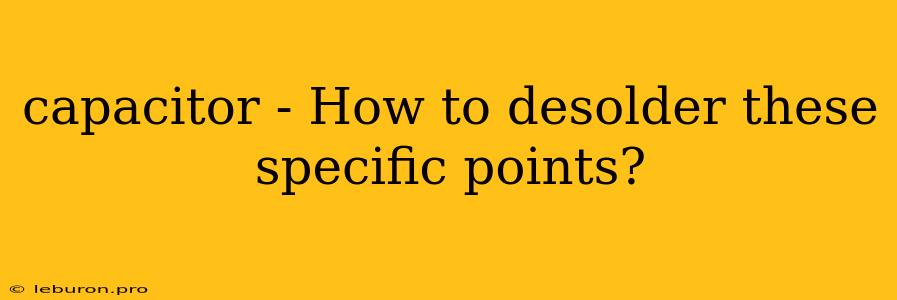Capacitors are essential components in electronic circuits, playing a vital role in filtering, smoothing, and storing energy. While soldering capacitors can be straightforward, desoldering them can pose a greater challenge, especially when dealing with delicate components or tightly packed boards. This article delves into the nuances of desoldering capacitors, highlighting the importance of proper technique and providing a comprehensive guide to ensure success.
Understanding Capacitor Desoldering
Desoldering a capacitor involves removing it from its soldered connections on a circuit board. This process requires heat to melt the solder, allowing the capacitor to be lifted away without damaging the surrounding components. The key to successful desoldering is understanding the different techniques available and choosing the appropriate one based on the specific capacitor and circuit board.
Importance of Proper Desoldering
Proper desoldering is crucial for several reasons:
- Preventing Component Damage: Improper desoldering can damage the capacitor itself, the circuit board, or surrounding components.
- Ensuring Circuit Integrity: A poorly desoldered capacitor can leave behind solder residue, leading to short circuits or other issues.
- Facilitating Re-soldering: A clean and well-prepared solder joint makes re-soldering easier and more reliable.
Desoldering Techniques: A Step-by-Step Guide
Desoldering Tools
Before attempting to desolder a capacitor, ensure you have the following tools:
- Soldering Iron: A reliable soldering iron with a suitable tip size is essential.
- Desoldering Braid (Wick): Desoldering braid is a woven copper mesh used to absorb melted solder.
- Solder Sucker/Vacuum Desoldering Tool: This tool uses suction to remove molten solder.
- Tweezers: Fine-tipped tweezers help safely remove the capacitor once it is desoldered.
- Flux: Flux helps clean solder joints and improves the flow of solder.
Desoldering Steps
- Preparation:
- Power Down: Disconnect the circuit board from any power source to avoid electrical shock.
- Heat Sink: If possible, use a heat sink to protect sensitive components near the capacitor.
- Heating the Solder Joints:
- Soldering Iron: Carefully apply the soldering iron tip to the solder joints, melting the solder.
- Desoldering Braid: Position desoldering braid over the melted solder, allowing it to absorb the molten solder.
- Solder Sucker/Vacuum: Apply the solder sucker/vacuum to the molten solder to remove it.
- Removing the Capacitor:
- Tweezers: Carefully use tweezers to lift the capacitor away from the circuit board.
- Gentle Force: Avoid excessive force, as it can damage the capacitor or surrounding components.
- Cleaning the Solder Joints:
- Soldering Iron: If any solder residue remains, use the soldering iron to heat it up and remove it with desoldering braid or a solder sucker.
- Flux: Applying flux can help clean the solder joints.
- Inspecting the Circuit Board:
- Damage: Inspect the circuit board for any damage or solder bridges.
- Residue: Ensure that no solder residue remains on the circuit board.
- Cleanliness: Clean the circuit board with isopropyl alcohol to remove any flux residue.
Desoldering Specific Points
Desoldering capacitors located in specific areas of the circuit board can require additional attention and techniques.
Surface Mount Capacitors (SMCs):
Surface mount capacitors are common in modern electronics. They are mounted directly onto the surface of the circuit board without leads.
- Heat Gun: A heat gun can be used to heat the capacitor, melting the solder and allowing it to be lifted off the board.
- Hot Air Station: A hot air station provides more precise temperature control, minimizing the risk of damaging surrounding components.
- Desoldering Nozzle: Specialized nozzles can be used to direct hot air to the capacitor.
Through-Hole Capacitors:
Through-hole capacitors have leads that pass through holes in the circuit board.
- Desoldering Braid: This is an effective technique for removing solder from through-hole capacitors, particularly when the leads are close together.
- Solder Sucker: Using a solder sucker can be more convenient for larger capacitors or when the leads are spaced apart.
Capacitors in Tight Spaces:
- Desoldering Braid: This technique is particularly effective when working in tight spaces, as it can be used to remove solder without the need for direct contact with the capacitor.
- Solder Sucker: A solder sucker can be challenging to use in tight spaces, especially if the leads are close together.
High-Value Capacitors:
- Heat Gun: A heat gun can be used to heat the capacitor, but be careful not to overheat it.
- Hot Air Station: A hot air station provides better temperature control and minimizes the risk of damaging the capacitor.
- Desoldering Braid: Desoldering braid can be used to remove solder from the capacitor leads.
Ceramic Capacitors:
- Soldering Iron: Use a soldering iron with a small tip to avoid damaging the capacitor.
- Desoldering Braid: Desoldering braid is an effective way to remove solder from ceramic capacitors.
- Solder Sucker: A solder sucker can be used to remove solder, but be careful not to apply too much pressure.
Electrolytic Capacitors:
- Heat Gun: A heat gun can be used to heat the capacitor, but be careful not to overheat it.
- Hot Air Station: A hot air station provides better temperature control and minimizes the risk of damaging the capacitor.
- Desoldering Braid: Desoldering braid can be used to remove solder from the capacitor leads.
Safety Precautions
- Safety Glasses: Always wear safety glasses to protect your eyes from flying solder.
- Heat-Resistant Gloves: Wear heat-resistant gloves to protect your hands from burns.
- Proper Ventilation: Work in a well-ventilated area to avoid inhaling fumes.
- Grounding: Ensure that your work area is grounded to prevent static electricity from damaging components.
Conclusion
Desoldering capacitors can be a challenging but essential task for electronics repair and maintenance. Mastering the techniques described in this article and practicing proper safety procedures will enhance your desoldering skills and help you successfully remove capacitors from circuit boards without damaging them or the surrounding components. Remember, patience and careful attention to detail are key for a successful outcome. By following these steps, you can confidently desolder any type of capacitor with ease and precision.
